DACF Home → Bureaus & Programs → Maine Natural Areas Program → Communities, Plants, and Animals → Invasive Plants → Black Locust
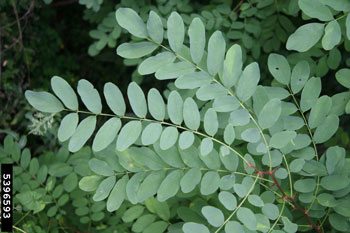 Black locust leaves, Robert Vidéki, Doronicum Kft., Bugwood.org
Black locust leaves, Robert Vidéki, Doronicum Kft., Bugwood.org
Black Locust
Robinia pseudoacacia
2019 Status in Maine: Widespread. Severely Invasive.
Description: Medium to tall (40-100'), fast growing deciduous tree, native to several southeastern and a few midwestern states. Bark of young trees is smooth green but becomes deeply furrowed and dark brown with age. Large spines grow in pairs on truks and branches, especially on suckering stems. Wood is dense and prized for its durability. Leaves: Alternate, 8-12" long, pinnately compound with oval leaflets up to 1" wide and 2" long. Blue-green, with lighter undersides. Flowers/Seeds: Typical pea flower in shape, white (rarely pink), with a yellow smudge in the center, ~1" wide, and fragrant; in loose, 8" long racemes that hang in large numbers from the branches. Late flowering tree in Maine (mid-June). Fruits are pods, 2-4" long and ½" wide, each containing 4-8 seeds. Dried pods often remain on trees through winter.
Native range: Southeastern U.S., Pennsylvania to Georgia, west to Missouria (Appalachia; Ozark Plateau). How it spread: Planted for its durable lumber, also as an ornamental and for soil stabilization.
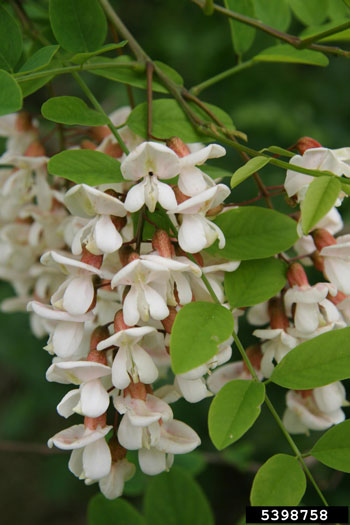 Black locust flowers, Robert Vidéki, Doronicum Kft., Bugwood.org
Black locust flowers, Robert Vidéki, Doronicum Kft., Bugwood.org
Reproduction: By seed and by suckers. Flowers require pollinators. Fragrance and nectar make for high rates of visitation. Seed bank longevity is likely high. Suckering can establish large clones.
Habitat: Prefers sun and well-drained soils. Common in disturbed sites and forest edges as well as roadsides, logging roads, hedgerows, and gravel pits. Its association with nitrogen fixing bacteria allow it to invade open canopy plant communities associated with sandy, nutrient poor soils.
Similar native species: None.
Similar non-native species: Honey locust (Gleditsia triacanthos) has bipinnately compound leaves and dense clusters of large, multi-pronged thorns on its branches and trunk. Siberian pea-shrub (Caragana arborescens) is much smaller with yellow flowers and no thorns.
Documented Ecological Impacts
- Black locust changes soil chemistry by fixing nitrogen and can result in a higher number and great cover of non-native and invasive species, even years after the black locust is removed. (Von Holle, B. et al. 2013. Ecosystem legacy of the introduced N2-fixing tree Robinia pseudoacacia in a coastal forest. Oecologia 172:915-924)
- Black locust lengthens the fire return time in globally rare pitch pine – scrub oak forests, causing the fire-adapted trees and understory plants to become shaded out. Other oak-dominated forest types are also considered vulnerable to black locust establishment. (Stone, K.R. 2009. Robinia pseudoacacia In: Fire Effects Information System, U.S. Department of Agriculture, Forest Service)
- Black locust is known to invade pitch pine woodlands and barren communities, all of which rare in Maine and some are rare globally. Since these are rare habitats, invasions in these areas are of top concern for conservation of biodiversity.
Fact Sheets and Identification Links
- Black locust fact sheet, University of California Weed Research and Information Center
- Black locust fact sheet, Michigan Natural Features Inventory
- Black locust fact sheet, Plant Conservation Alliance
- Black locust fact sheet, Natural Resources Conservation Service
- Black locust identification video (1:32)
- Go Botany page for Black locust
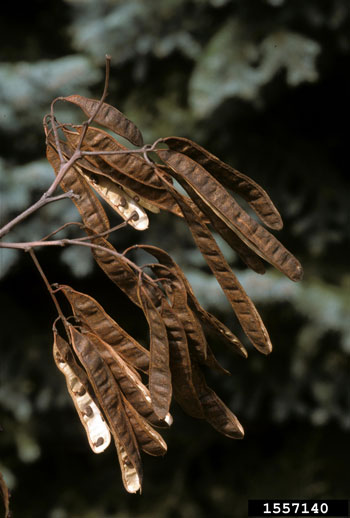 Black locust dried seed pods, Ohio State Weed Lab , The Ohio State University, Bugwood.org
Black locust dried seed pods, Ohio State Weed Lab , The Ohio State University, Bugwood.org
Control Methods
Seedlings can be hand pulled; saplings can be pulled with a weed lever or cut, but re-sprouting will occur so follow-up will be necessary*. Larger trees can be cut, but will also re=sprout unless the cut stump is immediately treated with concentrated herbicide† (triclopyr or glyphosate). However, this is not effective in early spring due to sap rising. Repeated follow-up cutting can control re-sprouting from cut stumps, but persistence is required, sometimes for many years. Foliar spray (glyphosate or triclopyr) can also be effective for seedlings, short saplings, or re-sprouts, as long as you can reach the top of the plant. For stems up to about 4-6: diamter, basal bark treatment can be effective (spray lower 18-24" of trunk with triclopyr in penetrating oil). In urban or suburban areas where trees provide valuable shade, a phase-out approach with re-planting of native trees may be advisable.
* Correctly dispose of all plant parts↵ † Follow all label directions when using herbicides↵Control Technique Links
- Penn State College of Agricultural Sciences, plant management guidelines.
- New Earth Landscaping video on control methods in turf settings (2:31)
- Wild Ones Louisville video on ecological impacts and control methods (3:14)
- The Woodland Steward video on ID and control in natural areas (14:40)
Please email invasives.mnap@maine.gov if you have questions about invasive species in Maine
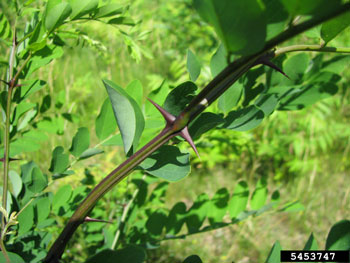 Paired thorns on black locust branch, Leslie J. Mehrhoff, University of Connecticut, Bugwood.org
Paired thorns on black locust branch, Leslie J. Mehrhoff, University of Connecticut, Bugwood.org
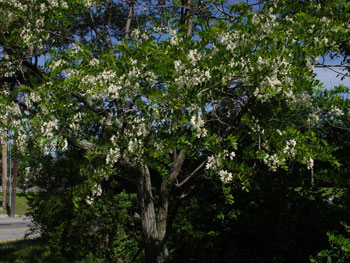 Black locust tree in flower
Black locust tree in flower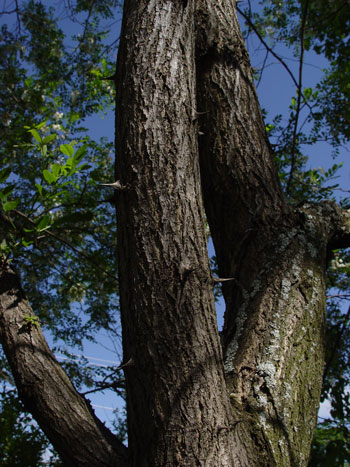 Spines on black locust trunk
Spines on black locust trunk
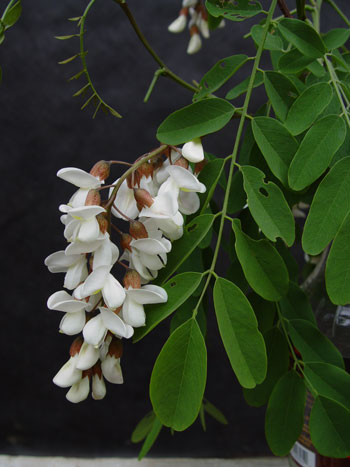 Black locust branch with leaves and flowers
Black locust branch with leaves and flowers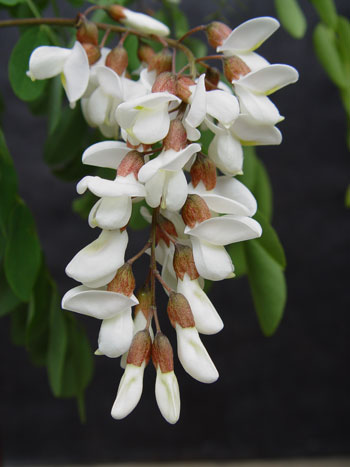 Black locust flowers
Black locust flowers
 Black locust tree in flower
Black locust tree in flower